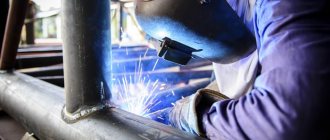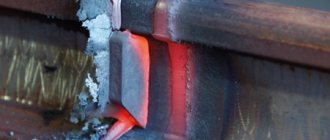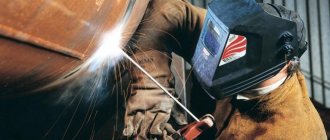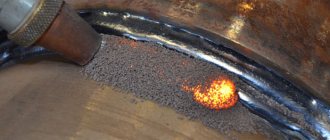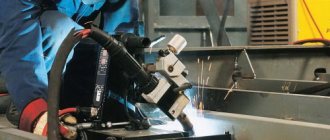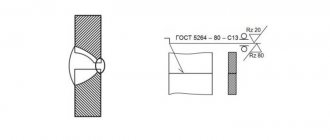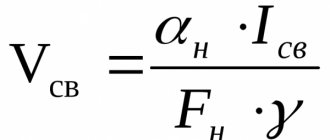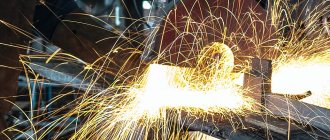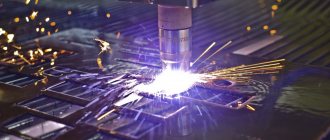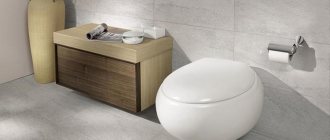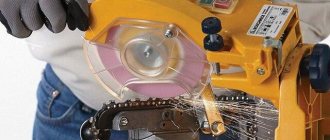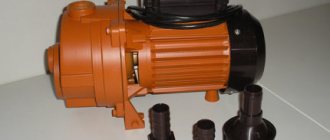Manual arc welding (also known as MMA, RD, RDS welding) with a carbon electrode was invented at the end of the 19th century by the Russian inventor Nikolai Bernardos. At the same time, the inventor patented his technology in many European countries. Later, he also invented resistance welding and gas-shielded arc welding.
Much time has passed since then, and the technology of manual arc welding has undergone many modifications. For example, among home craftsmen, it is not classic arc welding with a carbon electrode that has become widespread, but welding using consumable rods. Also, welding machines received many new functions, and metals with special properties began to be used in production.
Therefore, arc welding technology has become somewhat more complicated. In this article, we will tell you in detail what manual arc welding is, what are the advantages and disadvantages of this method of joining metals, and how RD welding of metal structures is performed.
general information
MMA manual arc welding (MMA is the common international name) is the process of forming a weld joint using an electric arc. The arc is ignited between the electrode and the metal surface, burns stably and forms an even seam. Electrodes for welding welding are made of metal wire and have a special coating that protects the welding zone from the negative effects of oxygen. The work uses electrodes up to 45 centimeters long.
In manual welding, the arc is ignited either by the tapping method (the welder taps the end of the electrode on the surface of the metal without using force) or by the striking method (similar to a matchbox). The arc melts the metal and the electrode melts at the same time as the workpiece. When the electrode melts, the metal is fused and a seam is formed. Minor metal spattering is acceptable.
Manual MMA arc welding using coated electrodes is one of the simplest types of welding. Hence there are many nuances in the work. With this welding method, working time is spent irrationally, a lot of effort is spent on forming a seam, and labor productivity decreases. Therefore, this technology is more in demand among home craftsmen than at a large factory.
But with the help of RDS you can surfacing shafts, welding many types of metals and relatively quickly repair metal products at home. Also, if you have experience and qualifications, you can make different types of seams, including labor-intensive ones, such as ceiling ones.
Technology Brief
When manual electric arc welding is used, the metal is quickly heated to its melting temperature by the action of an electric arc, which occurs as the effect of air breakdown between the electrode and the mass (parts being welded). Additional material is introduced into the weld, which allows you to fill the gap between the parts being welded.
At the heating point, a so-called weld pool is formed, which is a zone of mixing of the molten metal of the part with the additive material.
Light molten slag floats up - this is the burnt coating of a consumable electrode or the remains of a non-consumable rod. The slag protects the hot metal from the harmful effects of gases in the atmosphere.
This influence can lead to oxidation of the seam and the penetration of gas atoms into its structure, as a result of which the seam will not acquire the required strength.
Manual arc welding is performed with a consumable or non-consumable electrode. The first is itself a filler material, the second requires the introduction of filler wire into the melt.
There are various hand welding technologies. The least complex and costly of them requires only an AC or DC welding machine and the necessary equipment for the welder, but this method is suitable, as a rule, only for ferrous metals that normally tolerate contact with oxygen. To protect the weld pool, where steel and iron are melted, only the environment generated by the protective coating of the electrode is sufficient.
More complex methods, such as argon arc welding, require a special torch with a nozzle through which argon or other shielding gas is supplied.
The welding arc is initiated by a short circuit when the electrode contacts the ground. The arc temperature can reach 5000 °C.
Advantages and disadvantages
It is not for nothing that manual arc welding with a consumable electrode is the most popular method of joining metals. With its help, you can perform simple repairs, form short strong seams, and carry out quick maintenance of some equipment. But that's not all the advantages.
Compared to other technologies, welding machines for RDS welding are inexpensive, they are compact and easy to use. Also, the work does not require additional protection of the welding zone with gas or flux, since the electrode copes with this task. Another plus is the ability to work in almost any conditions: on the street, in the workshop, in the wind, and under the scorching sun. And this is important if you need to make quick repairs in the field.
Do not forget that the RDS is suitable for welding a wide variety of metals: from carbon and alloy steels to cast iron, aluminum and copper. At the same time, the thickness of the parts can reach several centimeters and a powerful welding machine will cope with this task. It is also possible to weld in any spatial position, if necessary.
Now about the disadvantages. Metal workmanship requires frequent breaks in work. They are necessary to replace the melted electrode with a new one. And its consumption can be very high in the absence of experience or when welding thick metals. If the electrode has reached a length of 5 centimeters or less, it should be replaced immediately.
Manual welding using an electrode involves the formation of slag around the weld zone and seam. On the one hand, this is good, since the slag additionally protects the weld pool from oxygen. But after work, the slag must be removed from the metal surface. This process can be labor-intensive and time-consuming.
Because of these two disadvantages, manual arc welding is considered one of the slowest. It leads to time overruns and cannot be compared with competitors such as MIG welding. You must take this disadvantage into account.
Due to the fact that the electrodes cannot be fully used in the work, and it is customary to often replace them with new ones, there is an overconsumption of components. It turns out that no more than 70% of the electrode is used in the work, the rest is considered cinder. This fact increases the cost of work.
Despite its relative versatility, RDS cannot weld tin or zinc. And in general all metals with a low melting point. This is due to the fact that the heat input coefficient is too high when welding with an electric arc. Also, manual arc welding with a consumable electrode is not suitable for joining parts made of titanium, tantalum and any other metals with active chemical properties. The electrode will not be able to adequately protect the seam from oxidation.
Well, there is one last minus that needs to be mentioned. In manual arc welding, the current passes along the entire length of the electrode, and if the current value is too high, the rod may overheat and the protective coating will be destroyed. Because of this, you simply cannot set high current values in order to somehow speed up the operation. This is another reason why work speeds when manually welding metal structures may be slower than when using other welding methods.
Operating principle of arc welding
An electrical cable of large cross-section (16 mm² or more) supplies the output voltage of the welding machine to the holder with the electrode. Two metal parts prepared for welding that need to be connected are connected to another ground cable. At the moment the end of the electrode comes into contact with the parts, the electrical circuit is closed, which essentially leads to a short circuit. Since the surface of the metal has roughness, the current heats them up and forms an electric arc. To prevent the electrode from “sticking”, the welder, at the moment of contact, breaks the direct contact and moves it away from the surface to be welded a few millimeters. If this is not done, the arc will not form and the device will operate in overload mode.
Due to the ionization of the gas at the point of contact, when the electrode is removed at a distance from the part, the arc does not stop burning. Under the influence of high temperature (over 5000º C), a groove with molten metal is formed in the surface, which is called a “bath”. In turn, the electrode rod also begins to melt and its drops, flowing down, mix with the metal in the groove, forming a filled seam after cooling.
Impurities coated with the electrode rod during combustion form a gaseous environment at the welding site. This environment protects the thermal seam from the destructive effects of nitrogen and other gases that make up the earth’s atmosphere. Another noteworthy point is that under the influence of the electromagnetic field and the movement of the resulting gases, regardless of where the electrode is located during welding, at the top (floor) or bottom (ceiling), the movement of molten metal occurs from the electrode to the part. It is this flow that displaces the liquid, hot metal from the “bath”, as if burning a groove into the depths. This splashing of metal from the “bath” can be observed during welding, when hot drops hiss and splash in different directions.
The depth of the burnt groove is directly related to the thickness of the electrode used and the value of the supplied current. The thicker the electrode and the higher the current, the deeper the metal is burned.
In view of this, it is necessary to select the correct cross-section of the electrode and the output current of the welding machine. In order not to burn through the metal, or vice versa, it is not enough to warm up the parts for a good connection.
Welding Features
Understanding the principle of manual arc welding with a consumable electrode, you can begin the welding process itself. First, let's figure out in what cases such welding is advisable. RD for metal is advisable if the thickness of the part starts from 2 millimeters and does not exceed 50 millimeters. It is also advisable to weld alloy, carbon and stainless steels. RDS is perfect for small-scale production or for welding piece products. If the metals are thicker and there are a lot of parts, then we recommend replacing MMA welding with MAG.
If the parts are too thin, they will melt too quickly. This leads to the formation of defects; the seam simply does not have time to form. Even if you set the current to the minimum value. Use other technologies for welding thin metal, do not take risks.
We wrote above that welding of parts up to 50 millimeters thick is possible. But we still recommend connecting metals with a maximum thickness of 20 millimeters. Welding thick parts is not economically viable when using manual arc welding technology. All these rules do not apply to the situation where you need to weld a short seam to make a small repair. If the welding area is too small, you will not use expensive equipment, gas, fluxes, etc. In such situations, manual MMA arc welding is quite appropriate when welding parts up to 200 millimeters thick.
Manual arc welding technology starts with the basics about spatial position. We wrote that manual arc welding with a consumable electrode is possible in any position. This is true, but with reservations. The fact is that not all electrodes allow you to make complex ceiling or vertical seams. They melt too quickly and the flowing metal does not allow the formation of a seam. Please pay attention to this before performing important work.
For this reason, the best result is achievable in a lower or horizontal spatial position. Such work can be performed by a welder even with low qualifications; you can use electrodes of larger diameter and set a higher amperage on the welding machine to speed up the work process. So if you can replace the ceiling seams with lower ones, do not refuse this decision.
If you are using the manual arc welding method with coated rods and still need to make a ceiling weld, then select small diameter electrodes and set the welding current to the minimum value on the machine. Do not work slowly or quickly, try to find the “golden mean” in the speed of the arc. Lead the arc confidently and do not deviate to the sides.
Now let's talk about the type and polarity of the current. MMA welding can be performed continuously or alternatingly; the choice of mode depends on the electrodes. Be sure to read the packaging of your rods before use; some electrodes may only be designed to operate on one type of current.
One thing is certain - with direct current the arc burns more stable than with alternating current. This is noticeable even when using universal rods that can work with any kind of current. In short, if you are a beginner welder, then purchase universal components and experiment with the settings.
As for the polarity, its choice depends on what speed of melting of the electrode you need. If you select reverse polarity and set the current to constant, the electrode will melt more slowly and evenly. This is the most acceptable option. There are electrodes that work well with any polarity.
Manual welding of iron or nickel has its own difficulties. In operation, metal can be susceptible to a problem called magnetic blowing. Magnetic blowing is when the arc begins to involuntarily deviate from the weld pool due to the magnetic properties of the metal. To avoid these problems, install alternating current on your welder, this may help.
Technical capabilities
Manual welding has significant limitations on the thickness of the parts being welded; this is its main disadvantage. As a rule, sheets thicker than 10 mm are not welded using this method.
Others include the relatively low speed of the process and the direct dependence of the result on the skill of the welder. The manual welding process, like any manual process, is difficult to standardize: the result depends on many factors. Among them:
- type of current source;
- the power of the source;
- characteristics and properties of the processed alloy;
- edge thickness;
- compliance of the electrodes with the task assigned to them;
- well-chosen welding mode.
The peculiarities of arc welding are that a relatively low voltage and a very high current are used to produce it. The arc voltage ranges from 30 to 90 V (many welding machines for home use are rated at an average value of 48 V), but the current is very high - from 90 to 350 A.
Selection of electrodes
Electrodes are as important as adherence to welding technology. The quality of the future seam largely depends on their correct choice. You need to select rods in accordance with the metal you are going to weld. Many characteristics of an electrode can be recognized by its markings. We talked about how to read the markings in this article.
When working with manual arc welding, pay attention to the properties of the electrodes you choose. Properties depend on the type of coating. Electrodes for RDS most often have a rutile or basic coating. We will not say which one is better. Let's just list their positive and negative sides.
Rutile-coated electrodes are often used by beginners because they are easier to ignite and maintain an arc. They are presented in a wide range, there are both budget and expensive brands. We do not recommend buying overly expensive electrodes for home welding, as they simply will not reach their full potential.
One of the disadvantages of rutile coating is the increased hydrogen content in the welded joint, which somewhat deteriorates the quality of the seam. But the metal practically does not spatter during welding, which is very important. For beginners, we recommend electrodes of the MP-3 brand, as they are one of the most affordable and widespread.
Basic coated electrodes are the choice of experienced professional welders. It is quite difficult to work with such rods, since the arc ignites reluctantly and must be very short during the welding process. All this requires experience. But if you are a beginner, do not be afraid to use such electrodes in your practice. This way you can learn faster. Basic coated electrodes provide excellent seam quality. If you need to weld relatively thin metal, then choose electrodes with a basic coating.
Electrodes are also selected based on economic factors. With such a slow welding method as RDS, it is important to know the deposition rate of the rod in order to determine how much time and electrodes will be needed to form the weld. There are special high-performance rods that make work faster. But, as a rule, they can only weld horizontal seams.
We wrote above that the electrode should be used at 70% percent, leaving approximately 5 centimeters of the rod. Some beginners deliberately overuse electrodes, using only half of them. Many people explain this by saying that they are simply worried about the length of the electrode and prefer to leave the rod with a reserve. We do not recommend doing this in our practice. You will have to interrupt welding even more often and change the electrodes with new ones.
Selection of welding parameters
The main parameters of arc welding are current and voltage (but it is fixed). Frequency is less important, since nowadays, as a rule, installations for DC welding are used - inverters.
For welding using electricity, regardless of the method, a direct proportional relationship applies: the thicker the metal, the greater the current should be at a fixed voltage. For comparison: sheets 3 mm thick are cooked with a current of 175-185 A, 5 mm - at least 200 A, 10 mm - 300-330 A.
It is strongly recommended that, in order to avoid burning and severe spattering of the metal, weld with the minimum current possible.
But at the same time, the thickness of the welding electrode and its correspondence in chemical composition to the metal that is supposed to be processed is also very important.
A standard arc welding electrode has a thickness of 3 mm. It is suitable for welding parts with an edge thickness of 2-3 mm. For thicker metal, you can follow the rule that the diameter of the electrode should be 1-2 millimeters less than the thickness of the metal plates that are supposed to be connected with it.
The maximum thickness of electrodes produced by industry is 6 mm. They are suitable for welding ten-millimeter steel sheets.
Each pack of electrodes has its own marking, indicating for what purpose they are intended.
What is welding
Welding is one of the leading technological processes of metal processing.
The great advantages of welding have ensured its widespread use in the national economy. Welding is used to produce ships, turbines, boilers, aircraft, bridges, reactors, high-rise buildings and other necessary structures. Welding is the technological process of obtaining permanent connections by establishing interatomic bonds between the parts being welded during their local or general heating, or during plastic deformation, or the combined action of both.
A welded joint of metals is characterized by the continuity of their structures. To obtain a welded joint, it is necessary to carry out intermolecular adhesion between the parts being welded, which leads to the establishment of an atomic bond in the boundary layer.
If the cleaned surfaces of two metal parts to be joined are brought together under compression under high pressure so that a common electron cloud can arise, interacting with the ionized atoms of both metal surfaces, then we obtain a strong welded joint. Cold welding of ductile metals is based on this principle.
As the temperature at the junction of parts increases, the amplitude of vibrations of atoms relative to the constant points of their equilibrium state increases, and thus conditions are created for easier connection between the parts being connected. The higher the heating temperature, the lower the pressure required for welding, and when heated to melting temperatures, the required pressure becomes zero.
The physical essence of the welding process is very simple. The surface atoms of a piece of metal have free, unsaturated bonds that capture any atom or molecule that comes within range of interatomic forces. By bringing the surfaces of two pieces of metal closer to the distance of action of interatomic forces or, more simply, until the contact of surface atoms, we obtain, along the surface of contact, the fusion of both pieces into one monolithic whole with the strength of the connection of a solid metal, since the same interatomic forces act inside the metal and along the surface of the connection. The connection process after contact occurs spontaneously (spontaneously), without energy expenditure and very quickly, almost instantly.
The combination of individual volumes of a condensed solid or liquid phase into one common volume is accompanied by a decrease in the free surface and the energy reserve in the system, and therefore the thermodynamic process of combination must occur spontaneously, without supplying energy from the outside. A free atom has an excess of energy compared to an atom in a condensed system, and the addition of a free atom is accompanied by the release of energy. Such spontaneous association is observed between volumes of homogeneous liquid.
It is much more difficult to combine volumes of solid matter. It is necessary to expend a significant amount of energy and use complex technical techniques to bring the atoms being connected closer together. At room temperature, ordinary metals do not connect not only upon simple contact, but also upon compression with significant forces. Two steel plates, carefully polished and “fitted”, subjected to prolonged compression with a force of several thousand kilograms, are easily separated when the pressure is removed, without revealing any signs of connection. If connections occur at individual points, they are destroyed by the action of elastic forces when the pressure is removed. The joining of solid metals is hampered, first of all, by their hardness; when they come together, actual contact occurs only at a few physical points, and expanding the area of actual contact is quite difficult.
Metals with low hardness, such as lead, are firmly connected even with slight compression. With harder metals, the actual contact surface is very small compared to the total apparent surface, even on carefully machined and fitted surfaces.
Welding is a technological process of obtaining a tight, permanent connection of parts using molecular adhesion forces, while the connection material (weld) has the same physical and mechanical characteristics as the parts being connected.
All types of welding can be divided into two large groups - pressure welding and fusion welding.
Pressure welding uses the plastic properties of the materials of the parts being joined, while heating plays a secondary role or is not used at all. When pressure welding, the metal is heated to a plastic state due to the high electrical resistance of the contact zone and then upset by mechanical force, causing plastic deformation of the parts and their connection into one whole.
In fusion welding, the metal is heated to a liquid state (melting), and the edges of the parts being joined are melted simultaneously, forming a common pool of liquid metal; upon crystallization (solidification), the molten metal of the weld pool forms a strong connection that has a cast structure.
Thus, the welding process consists of the formation of strong bonds between atoms and molecules on the joined surfaces of the workpieces. For connections to form, the following conditions must be met:
- freeing the welded surfaces from contaminants, oxides and foreign atoms adsorbed on them;
- energetic activation of surface atoms, facilitating their interaction with each other;
- bringing the surfaces to be welded closer to a distance comparable to the interatomic distance in the workpieces being welded.
Depending on the form of energy used to form the welded joint, all types of welding are divided into three classes: thermal, thermomechanical and mechanical.
The thermal class includes types of welding carried out by melting using thermal energy (arc, plasma, electroslag, electron beam, laser, gas, etc.).
The thermomechanical class includes types of welding carried out using thermal energy and pressure (resistance welding, electric spot welding, diffusion welding, etc.).
The mechanical class includes types of welding carried out using mechanical energy and pressure (ultrasonic, explosion, friction, cold, etc.).
Based on the type of energy source used for heating, fusion welding can be divided into electric and gas. Gas welding uses the energy of combustion in an oxygen atmosphere of flammable gases - acetylene, substitute gases (propane, methane, hydrogen, etc.) and vapors of flammable liquids (gasoline, kerosene).
In electric arc welding, the main part of the heat required to heat and melt the metal is obtained due to the arc discharge that occurs between the metal being welded and the electrode. Under the influence of the heat of the arc, the edges of the parts being welded and the end of the consumable electrode melt, forming a weld pool, which remains in a liquid state for some time. When the metal hardens, a welded joint is formed. Energy required for
formation and maintenance of an arc discharge, is taken from DC or AC arc power sources. Arc welding is classified depending on the degree of mechanization of the welding process, the type of current and polarity, the type of arc, the properties of the electrode, the type of protection of the welding zone from atmospheric air and other characteristics.
What does marking mean?
It is impossible to imagine manual arc welding without electrodes. Their marking determines what metals they are intended for, what thickness and composition of the coating they have, in what position they should be held when welding (vertically, horizontally, at an angle), what metals they are intended for. The nature of the marking is alphanumeric.
The first letter after the name and brand of the electrode is the letter that determines its purpose. U - for low-alloy and medium-carbon steels, T - for heat-resistant alloy steels. The letter N is for surfacing, A is for ductile metals.
Next comes a letter indicating the thickness of the coating. M - thin coating, C - medium, D - thick, G - extra thick.
The thickness of the coating is determined as a percentage relative to the rod itself.
The next letter of the code indicates the type of electrode. If it is the letter E, then the electrode is consumable.
This is followed by numbers that characterize tensile strength, relative elongation and impact strength retention temperature. They are important only for professional welders working in particularly critical production.
They are followed by one or two letters indicating the coating material of the electrode. A means acidic compound, B - alkaline, C - cellulose, R - rutile, P - other types. Mixed types of coating are possible, such as RC.
The last two digits of the code indicate one of the most important parameters - the position in space in which manual arc welding can be performed, and the current characteristics for welding.
For example, code “13” should be read as 1 and 3. 1 - you can cook in any spatial position, 3 - you must use a current of reverse polarity or an alternating voltage of 50 V.
